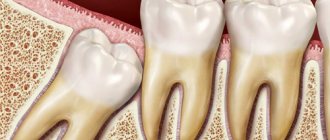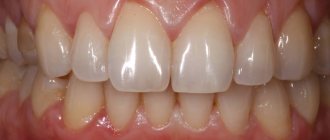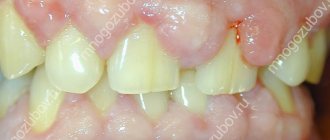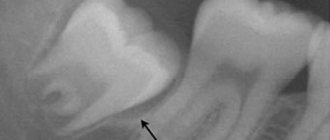The question often comes up on various forums: “what to do if the gums are swollen or swelling appears around the tooth”? In this case, there may be various accompanying symptoms: there may be pain in the gums, or there may not be; there may be a fistula, or there may not be; a tooth may hurt, gums may bleed, and there may be many other symptoms. Treatment of swollen gums in Samara directly depends on the reason for the swelling on the gums.
In this article, we will try to figure out what can cause swelling on the gums, what symptoms other than swelling can help determine the cause of this swelling, and what to do at home until you can see a dentist.
Why gums may swell, causes of swelling
- Exacerbation of periodontitis;
- Exacerbation of chronic periodontitis or gingivitis;
- Abscess.
Of course, these are not all possible causes of swelling on the gums, but about 90% of requests (if not more) fall within this framework.
Causes of edema
Swelling of the gums is a consequence of penetration of pathogenic bacteria into the soft tissues, causing infection.
Provoking factors:
- tartar formed due to poor oral hygiene;
- advanced form of caries;
- untreated stomatitis;
- infectious diseases of the throat;
- mechanical damage to soft tissues;
- difficult teething;
- immunodeficiency;
- vitamin deficiency (mostly severe lack of vitamin C);
- herpes virus activity;
- allergies to dental drugs or materials;
- development of purulent processes inside the tooth;
- the presence of tumors on the tooth root;
- gum diseases.
Before making a diagnosis, the dentist will definitely prescribe diagnostics to determine the internal state of the tissues, which will more clearly define the clinical picture and identify the main cause of the pathology.
Reasons for taking so long for teeth to erupt
- The wisdom tooth is very large and there is no room for it.
- Dense bone tissue makes tooth eruption difficult.
- Due to crowding, the tooth does not occupy a natural position: it grows at an angle or parallel to the gum.
Pericoronitis
If the wisdom tooth is slowly erupting, a gum hood may appear over it. This hood prevents the tooth from growing and is a favorable place for food debris and saliva to accumulate. Pathogenic microbes can begin to multiply on this fertile soil.
At the initial stage of development of pericoronitis, it can be stopped with antibacterial drugs. If the disease has developed into a purulent stage, and the patient shows all the signs of infection of the whole body, then the doctor performs a small operation - he cuts the gum and cleans out the pus, thereby helping the tooth to erupt.
Caries
If carious cavities appear on the figure eight, the gums may become inflamed and the tooth will begin to ache. In addition to caries, wisdom teeth are characterized by diseases such as pulpitis and periodontitis. These diseases can be detected by visual examination of the tooth or by x-ray. Treatment depends on the number of cavities and the condition of the paired molar on the opposite jaw.
Other causes of gum inflammation figure eight
- The gums can become inflamed from mechanical trauma or after a burn to the gum tissue.
- With hormonal changes in the body in pregnant women or during menopause.
- For thyroid disease.
- from removable dentures.
- For diseases of the throat and genitourinary system.
- When using hormonal drugs.
Associated symptoms
Often gum swelling is accompanied by other symptoms:
- swelling of the cheek;
- fistula formation;
- tooth pain;
- bleeding gums;
- sensation of a metallic bite;
- redness of the gums;
- discharge of pus from the carious cavity;
- loosening of the crown;
- the appearance of ulcers;
- increase in general body temperature;
- the appearance of white plaque on the gums.
If there are signs of a purulent process, then contacting a dentist should be done immediately. Complications can lead to serious consequences not only for the oral cavity, but also for the entire body.
Pain in the gums at the end of the lower jaw after tooth extraction
As a rule, after a tooth is pulled out, pain can persist in that place for a long time. This is an absolutely natural reaction and nothing terrible can happen. But there are other reasons for pain after tooth extraction, which can lead to negative consequences:
- Jaw injury;
- Infectious diseases;
- Swelling of the jaw.
When pain after tooth extraction bothers you for a long time, you need to visit the dentist again and make sure that nothing threatens your health. If the pain is caused by the reasons described above, then immediate treatment is prescribed. By contacting your dentist in time, you can quickly and painlessly cure the problem.
Possible dental diseases
In 90% of cases, swelling of the soft tissues around the tooth appears with the development of periodontitis, gingivitis, periodontitis or an abscess. Other possible causes are extremely rare.
Periodontitis
With the development of periodontitis, the inflammatory process affects the bone tissue of the jaw. The cause of the pathology is the penetration of infection of the dental root canals and its spread. Swelling of soft tissues during periodontitis is caused by the accumulation of pus. If left untreated, pus may be released through the resulting fistula. The swelling subsides during this period, but the inflammation cannot be eliminated on its own. Treatment is mandatory.
Gingivitis
A distinctive feature of gingivitis from periodontitis is the development of an infectious and inflammatory process in the soft tissues surrounding the tooth. Swelling of the gums with gingivitis mainly occurs during the period of exacerbation. The swelling of the gums can be so severe that the tissue covers the tooth.
Periodontitis
The development of periodontitis occurs against the background of advanced periodontitis. Lack of treatment provokes a purulent process with a localized abscess area. With a periodontal abscess, a cavity forms under the gum in which pus accumulates. Externally, in addition to edema, a pronounced swelling in the form of a semicircle up to 1–2 cm in size appears on the soft tissue. Treatment is carried out surgically.
Sore gums: what to do?
If your gums hurt and are even swollen, you should immediately contact a periodontist. This is a dentist of a narrow profile, and it is better not to delay a visit to him if discomfort appears and the first signs of inflammation on the mucous membrane. It is this specialist who diagnoses and treats periodontal tissue diseases. You should also contact a periodontist regarding the prevention of gum disease.
What is the purpose of periodontal treatment?
- Removing dental plaque
- Cleaning periodontal pockets
- Preventing the spread of infection
- Activation of the immune system
- Development of a preventive measures program
Gum treatment will be most effective and successful at the initial stage of the disease.
If your gums hurt
- Use a soft toothbrush and special toothpaste
- Brush your teeth correctly and regularly
- Use dental floss, mouthwash and irrigator
- During treatment, avoid very hot, cold, sweet and salty foods.
- Temporarily avoid eating solid foods
What can happen if your gums are left untreated?
Many people ignore bleeding and inflammation of the gums because they consider these symptoms to be frivolous, but this opinion is wrong. If left untreated, the periodontal junction is gradually destroyed, teeth become loose and fall out.
According to statistics, gingivitis and periodontitis are increasingly diagnosed every year in patients aged 30–40 years. If you do not seek help from a doctor, then after 10–15 years, in some of them the disease goes from mild to severe, and teeth may begin to fall out.
Treatment methods
Depending on the cause of gum swelling and accompanying pathological processes, the doctor may prescribe conservative treatment, or resort to surgical manipulation or tooth extraction. The clinical picture is determined by the results of examination and radiography.
Conservative therapy
When visiting a dental clinic, a specialist eliminates the cause of gum swelling and then begins to eliminate inflammation, symptoms and associated pathological processes.
The patient may be prescribed drug therapy, including:
- antiviral;
- painkillers;
- antibiotics;
- antihistamines.
Local therapy that has an antiseptic effect is required. The dentist may recommend the use of special ointments or gels, rinsing the mouth with medications or herbal decoctions.
Surgery
The help of surgical dentistry is necessary for certain indications. The need for surgical intervention arises with the development of a purulent process. The specialist will need to open the gum, fistula or root canal to release the pathological fluid. Next, the affected cavity is cleaned, treated with an antiseptic, and treatment of the underlying disease begins. Swelling of the gums can be a sign of a serious pathology that requires tooth extraction. The need for extraction or the possibility of saving the tooth is assessed by the doctor.
Sore gums: how to treat?
Competent and effective treatment of gums can only be carried out by a periodontist. Depending on the diagnosis and stage of the disease, he can prescribe a number of therapeutic measures to the patient.
- Professional hygiene . This is a mandatory procedure performed by a hygienist. In one procedure, it removes all dental deposits and bacteria living in them, not only from the surface of the teeth, but also under the gum. In addition, the hygienist will correct your home oral care, show you how to brush your teeth properly, and select a brush and products for you, taking into account your individual problems.
- Treatment with the Vector device. For effective treatment in scientific dentistry "Naudent" they use the Vector device (Germany). It delicately cleans the periodontal pocket to a depth of 11 mm and works gently even in the most difficult to reach places, ensuring maximum cleanliness. Thanks to ultrasound, Vector-therapy destroys the biofilm of microorganisms, and a powerful flow of liquid removes it from under the gums. A special solution washes and disinfects the gums. Thanks to its gentle effect, the system allows you to effectively and at the same time completely painlessly reduce the depth of periodontal pockets. Bleeding, pain and swelling disappear.
- Plasmolifting. The patient's blood plasma is injected into the inflamed areas of the gums by injection. This procedure is absolutely painless and has a beneficial effect on the condition of the gums: bleeding and inflammation disappear, and tooth mobility decreases. It is important that the healing effect is noticeable after the first procedure.
- Physiotherapy. A course of physiotherapy may include electrophoresis, massage, photodynamic therapy and ultrasound treatment. These procedures are prescribed as an addition to the main treatment. They have a complex effect, improve prognosis and reduce treatment time.
- Surgery. In advanced cases, when the inflammation has gone too far and therapeutic methods have not shown the desired result, the periodontist can only carry out surgical treatment. This may be curettage, gingivectomy or gum grafting. Doctors at scientific dentistry "Naudent" use the Fonalaser laser (Germany) for this purpose. It removes diseased gum tissue with virtually no pain or bleeding, and the recovery period is quick. Also, a diode laser is used to correct the gingival margin and remove tumors.
If you can’t go to the doctor right now, and your gums hurt, then you can temporarily reduce the level of inflammation on your own with the help of:
- Dental gels for gum pain relief
- Herbal rinses to relieve inflammation (chamomile, sage, eucalyptus)
Only an integrated approach can effectively solve problems with gum disease and forget about pain for a long time. Remember that it is important to take care not only of dental health, but also to monitor the condition of the entire oral cavity.
Endodontic treatment and filling
Sometimes after therapeutic treatment, gums become swollen and teeth hurt. This phenomenon can be observed within 2-3 days after removal of the nerve and treatment of the canals. But if the pain does not subside or go away within a week, unfilling and re-treatment are required.
If your gums hurt for a long time after filling, do a little experiment. Pass dental floss between the teeth at the site of inflammation: it should not cling to anything. If the thread does not pass easily and freely, then the problem is that the filling is not polished enough. Contact your dentist and he will quickly eliminate this defect.
Which doctor should I contact?
Only a dentist can accurately answer the question of what to do if your gums hurt. Many people, faced with gingivitis, periodontitis, diseases of the oral mucosa and even injuries, self-medicate12. The source of information about medications in most cases is not the attending physician at the appointment, but the Internet, television, radio, as well as advice from relatives and friends12. It is important to understand that self-medication can lead to the development of a number of complications12.
Top
The information in this article is for reference only and does not replace professional advice from a doctor. To make a diagnosis and prescribe treatment, consult a qualified specialist.
Bibliography
- The state of the dental status of the adult population depending on the presence of diseases of the oral mucosa / Mama before in R. M., Alizade A. R., Ibragimova L. K., Gamzaev B. M. // Problems of dentistry. - 2013. - No. 5. - P. 18-20.
- Prevention and treatment of diseases of the oral mucosa. Omarova K.V. // Bulletin of Surgery of Kazakhstan. - 2011. - No. 4. - P. 128.
- Therapeutic dentistry. Textbook / Borovsky E. V. Ivanov V. S., Maksimovsky Yu. M., Maksimovskaya L. N. / Moscow, 2011.
- Stomatitis. MSD Handbook. Professional version - URL
- Main diseases of the oral mucosa. Borodovitsina S.I. et al. /Ryazan: Atlas, 2021.
- Chronic recurrent aphthous stomatitis. Maltabarova B. A. // Bulletin of Surgery of Kazakhstan. - 2011. - No. 3. - P. 106.
- Chronic aphthous stomatitis in the practice of a dental therapist (literature review). Kosaeva Sh. K. // Bulletin of the Kazakh National Medical University. - 2014. - No. 1.
- A new word in the treatment of alveolitis. Shlegel Yu. V., Hartman R. V. // Medico-pharmaceutical journal “Pulse”. - 2007. - No. 4. - P. 412-413.
- Prevention and treatment of alveolitis / Rodionov N. T., Andreeva E. P., Dobrorodova S. V., Stoletnaya T. P. // Bulletin of the Smolensk Medical Academy. - 2010. - No. 2. - P. 110-111.
- Dental gel for gums “Metrogil Denta®” in the treatment of periodontal diseases and oral mucosa // Practical Medicine. - 2009. - pp. 105-106.
- Instructions for medical use of the drug METROGYL DENTA®.
- Self-treatment of periodontal diseases and oral mucosa. / Tsepov L. M. et al. // Bulletin of the Smolensk State Medical Academy. — 2021.
Gingivitis
This is the most common disease of periodontal tissue, which is accompanied by bleeding, inflammation and swelling. Occurs in adults and children of any age. Timely treatment by a periodontist can completely eliminate the disease.
According to the nature of the disease, it can be:
acute - begins abruptly and develops rapidly
chronic - a sluggish process with mild symptoms
aggravated - a sharp increase in the symptoms of a chronic disease
remission - the process of disappearance of all signs of the disease
The disease can be local in nature, that is, observed in a limited area, or be generalized and affect the gums completely. The initial stage of the disease is characterized by the appearance of painful sensations in the gums when pressing, intense chewing or sudden changes in temperature.
Gingivitis has several forms, and each of them is treated differently. The main thing is to consult a doctor in time to make an accurate diagnosis.
Literally every second woman suffers from hypertrophic gingivitis during pregnancy. It develops as a result of hormonal imbalance and poor hygiene. Only a specialist can eliminate inflammation and restore the oral mucosa.
Care and nutrition tips
During your consultation with your doctor, you will receive specific recommendations that you will need to follow. By adhering to them and our simple rules, you will quickly get better.
- Consult a periodontist about the correct choice of toothbrush and toothpaste
- Learn the rules of home hygiene from a specialist and follow them regularly
- Use additional hygiene products for daily care
- Avoid foods that are too hot, cold, very sour or salty.
- Avoid eating hard foods, which can further injure your gums.
- Eat less sugar, sweets, toffees, chocolate and other confectionery products
- Include more vegetables and fruits in your diet, take multivitamins
If your gums are bleeding, you should not treat this as a natural phenomenon in our body. It’s better to play it safe a hundred times and make an appointment with a dentist than to lose all your teeth at once.
If you haven’t been to see a doctor for a long time, it’s time to sign up for a preventive examination with the specialists of the Center for Modern Dentistry. After all, gums require the same responsible attitude as teeth.










